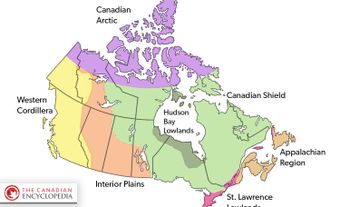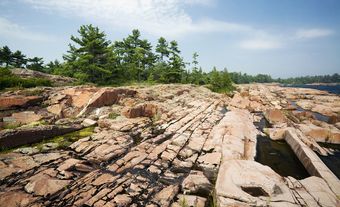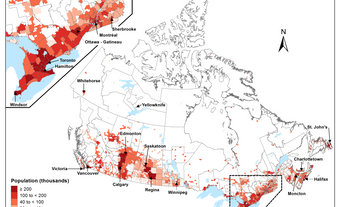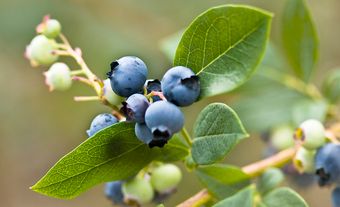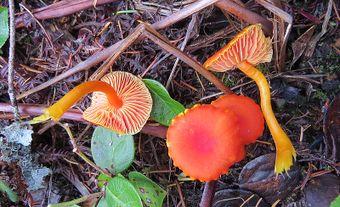Canada has seven primary vegetation regions, in addition to the marine flora found along the country’s coasts. Each region is characterized by distinct plant communities. The plants in each region are mostly determined by climate. Other factors that determine which plants grow in which region include geology, soil composition and erosion, water drainage patterns and human interference.
This article is a plain-language summary of Vegetation Regions. If you are interested in reading about this topic in more depth, please see our full-length entry, Vegetation Regions.

Arctic Tundra
The Arctic Tundra is the second largest vegetation region in Canada. It has no trees. The temperature is too cold to support trees. It has permafrost. This is ground that is always frozen. The Arctic tundra region can be divided into the Low Arctic and the High Arctic. The Low Arctic has small shrubs, sedges, lichens and mosses. In the High Arctic there are fewer plants. This is because the summers are colder and the growing season is shorter. There is also less precipitation. However, small shrubs, small cushion plants, lichens and mosses grow in about half of the High Arctic. At high elevations and in the northern islands the land is a polar desert. Almost no plants grow here.
Boreal Forest or Taiga
The Boreal Forest or Taiga is located south of the Arctic Tundra. It is Canada's largest vegetation region. The boreal forest extends from the Rocky Mountains to Newfoundland and Labrador and parts of Nova Scotia. The plants that grow in this region can survive cool, short summers and long, cold winters. In the southwest common trees include aspen, balsam poplar and white spruce. In the southeast aspen and white spruce trees are also common, as well as black spruce, balsam fir and paper birch. Further north, as the Boreal Forest transitions to the Arctic Tundra, black spruce and balsam fir are the most common trees.
Pacific Coastal
The Pacific Coastal Region receives significant rainfall compared to other vegetation regions in Canada. Coniferous forests grow on the exposed coasts of British Columbia’s islands and mainland. Common tree species include Douglas fir (except on Haida Gwaii), Western hemlock, yellow cypress, Sitka spruce, shore pine and Western red cedar. The Georgia Strait area of Vancouver Island and the adjacent mainland have a drier climate. Arbutus, the only broad-leaved evergreen tree in Canada, grows here, as does Pacific dogwood. Specialized plant communities grow on the region’s beaches. These beaches include a driftwood zone containing large logs from the forest trees. Common plants in the driftwood zone include American wild dune grass, beach pea and giant vetch. Finally, the Pacific Coast has many inlets. These inlets include salt marsh vegetation such as alkali grass, seaside arrow grass and pickleweed.
Cordillera
The Cordillera vegetation region is found in parts of British Columbia, Alberta, Yukon and the Northwest Territories. The region’s vegetation can be divided into 14 zones. These zones can be grouped into seven regions.
The Alpine Region is found north of the treeline at higher elevations in the mountains. Vegetation here is similar to that found in the tundra. It includes dwarf willows, mosses and lichens.
The Pacific Coastal Subalpine Forest Region is in the Coast-Cascade and Vancouver Island mountains of British Columbia. Mountain hemlock, Pacific silver fir and yellow cypress are the region’s characteristic tree species.
The Interior Cordilleran Subalpine Forest Region includes a zone where typical tree species include Engelmann spruce and subalpine fir. It is found in British Columbia and Alberta. White spruce is common throughout another zone in this region, found in British Columbia, Alberta, Yukon and the Northwest Territories,
The Boreal Montane Forest Region includes parts of British Columbia, Alberta, Yukon and the Northwest Territories. It is characterized by trees such as boreal white and black spruce, hybrid white spruce and lodgepole pine.
The Cordilleran Montane Temperate Forest Region includes a zone of primarily Western red cedar and Western hemlock. This zone is found throughout southeastern British Columbia, and on the east side of the Coast Mountains in northwestern British Columbia. Another zone, dominated by Douglas fir, is found on the eastern slopes of the Rocky Mountains and in southern British Columbia. A zone of lodgepole pine is found in the same area as well as in central British Columbia.
The two zones found in the Cordilleran Cold Steppe and Savannah Region are located in British Columbia’s dry southern interior. They are dominated by big sagebrush, bluebunch wheat grass and ponderosa pine.
The Pacific Coastal Mesothermal Forest Region is found on Vancouver Island, along the coast of British Columbia and in the valleys of the Coast Mountains. Two tree species characteristic of this region are Douglas fir and Western hemlock.
Prairie Zones
The Prairie Zones are located in Western Canada. It is a grassland area. There are four Prairie zones: mixed prairie, fescue prairie, tall grass prairie and Palouse prairie. The mixed prairie zone contains short and mid-height grasses such as common spear grass and Western wheat grass. The topsoil is brown. This zone is found in southwestern Saskatchewan and southeastern Alberta. The fescue prairie zone is in Alberta and western Saskatchewan. Here, the soil is black and main grass is rough fescue. The tall grass prairie zone is in southern Manitoba. Important grasses in this zone include bluestems and porcupine grass. The Palouse prairie zone is found in the valleys of southern interior British Columbia. Bluebunch wheat grass is a common grass in this zone.

Eastern Temperate Forests
This region is divided between deciduous forest in the south and deciduous-evergreen forest in the north. The deciduous forests of southern Ontario are home to 80 tree species. These species include oak, maple and beech trees. The deciduous-evergreen forest is found primarily in southern Quebec, and central and east-central Ontario. Many different types of tree species are found here, too, including pine, aspen, birch and spruce trees.
Atlantic Coastal Region
This region is part of the boreal forest. On the island of Newfoundland, the common tree species include white and black spruce, balsam fir, birch and poplar. In the Maritime provinces, red spruce is the dominant tree species. Deciduous trees include beech and oak.
Along the coast there are large areas of peatland and heath, particularly in Nova Scotia and Newfoundland. Peatlands are areas with poor drainage. Heaths are areas with short, shrub-like vegetation.

 Share on Facebook
Share on Facebook Share on X
Share on X Share by Email
Share by Email Share on Google Classroom
Share on Google Classroom

